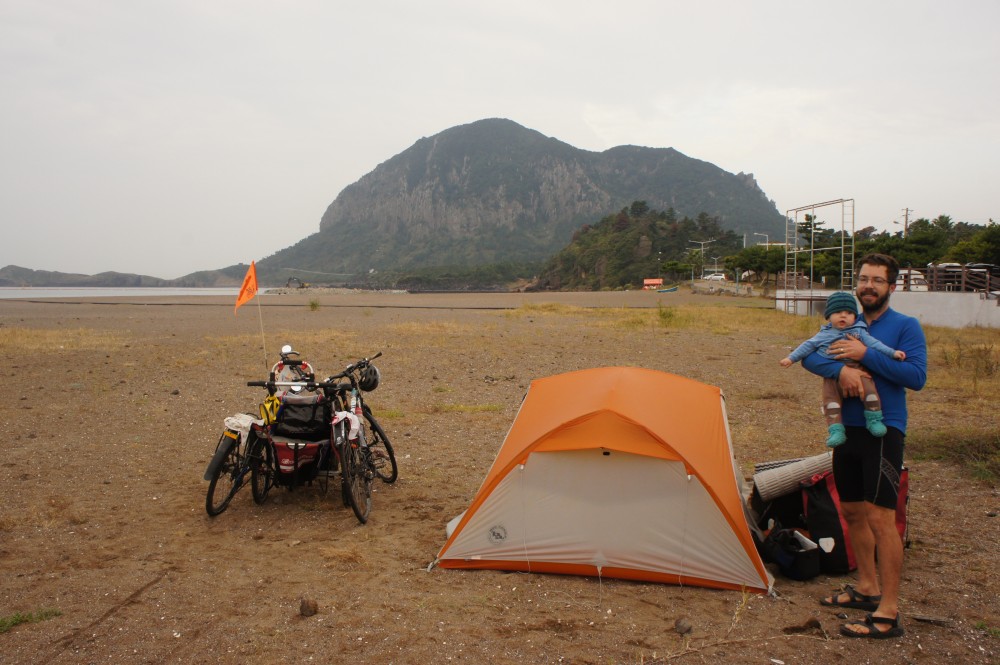
A Mini-Guidebook to Cycle Touring with a Baby/Toddler
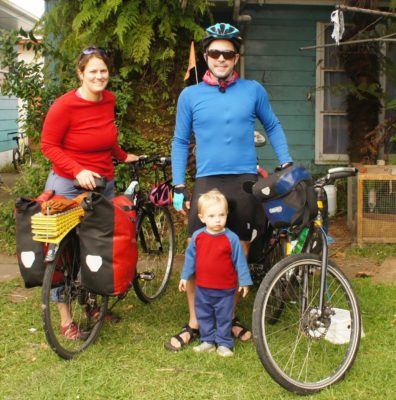
Recently a few people asked us about cycle touring in general and more specifically about cycle touring with a baby. Since the questions keep piling up we figured we’d put together a blog post about our recent experiences of cycle touring with our son Neil. Neil turned two in February and we have cycled with him in four overseas countries and have also done some short trips close to home, in British Columbia, and the nearby Washington state. Every time we go on a cycling trip with him we are amazed by how easy it is, and even though the worries keep on building up before the trip, once we start cycling everything seems to work out. Many times being together on a trip feels a lot easier than managing daily life at home. This is of course our individual experience and every family/child is different. We are not saying there aren’t challenges, but we feel that they just help us grow as a family and every trip is a memorable experience.
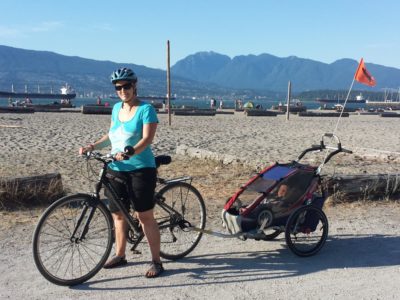
When to Start?
This is of course very individual and depends on you, your child and what you feel comfortable with. We started cycling with Neil in the trailer when he was four months old, although we know people who started even earlier (such as five weeks old). We bought a used trailer and started riding with him around the city and along the beach. For us it was a transformational moment. We love cycling and it’s always been our main mode of transportation. Being able to cycle with Neil really got us closer together and it was great to do what we loved with him.

Not long after we got the trailer we went on our first overnight trip by bike with Neil to Galiano Island. We had been there before so we were comfortable with the route and plan. The trip went well and we all had a great time. Later on that summer we mostly put our efforts into hiking, as we usually do in the summer months, but we kept on biking with Neil around the city and to Steveston, a favourite day trip of ours. When Neil was seven months old we went on our first overseas cycling adventure – a three month cycling trip to South Korea and Japan. Gili took five months parental leave which allowed us to go travelling comfortably and spend a lot of time together (basically 24/7…).
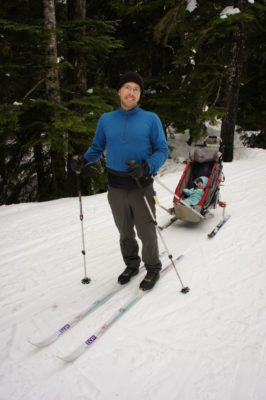
The Trailer
Our trailer is a Thule Chariot CX-1, which we would recommend. It has an adjustable suspension, windows that can be removed, extra storage and decent waterproofing. As a bonus, you can use it as a stroller, for cross country skiing, and jogging, if you get the additional kits. The Cougar is similar – it doesn’t have the removable windows, which are nice for hot weather. Both trailers are expensive, but you might be able to find a used one for less than half the full price, try Craigslist, eBay and similar sites. One bonus of using a trailer that doubles as a stroller is that a stroller normally travels for free on flights, just make sure to call it a “stroller” and not a “trailer”!

When we started riding with Neil, when he was four months old, we used the Thule Chariot Infant Sling. It’s like a mini-hammock for babies, and Neil certainly looked very comfy in it. Just before our trip to Korea and Japan, when Neil was seven months old, we noticed he was almost too big for it, so we switched to the Thule Chariot Baby Support which has some additional support around the head. We continued using the sling until Neil grew out of it, at which point we started just placing him in the trailer with no additional cushioning, which seems to work fine.
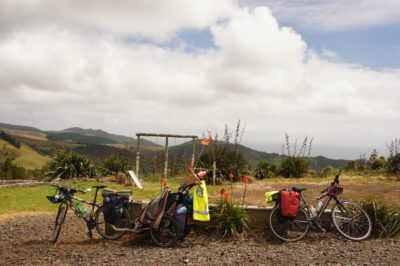
Gear
Since we we had been cycle touring for a number of years before Neil was born, we continued using much of the same gear. Our general recommendation is “not to sweat the gear” – use what you have when reasonable and upgrade key items as you go.
Our bikes are cheap commuters, chosen so as to avoid any additional attention from the very prevalent bike thieves in Vancouver. We find we are able to fit all our gear in two rear panniers each, strapping our sleeping mats on top, and carrying diapers and some associated gear in the back of the trailer. The panniers we use are the popular and waterproof Ortlieb Back Roller. As always, if you have extra money to spend, you could try to lighten your load. An often more efficient way to cut your load is to carry less, be it clothes, luxuries or even food (at the price of stocking up more often).
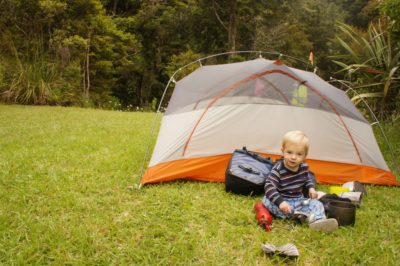
Our current tent is a Big Agnes Copper Spur UL3, which is roomy and light (1.8kgs), although we have not been impressed with its durability. A few years ago we finally upgraded our sleeping bags to the custom made ZPacks bags, which feature 900 fill and weigh only 600g for the 10F version – we like them a lot, but we’re a bit skeptical about the temperature rating. Our stove is an MSR Whisperlite International which we have been using forever. It has the advantage that it can burn both white gas, kerosene and car fuel, but the last two really clog things up. It also doubles as Neil’s favourite toy.
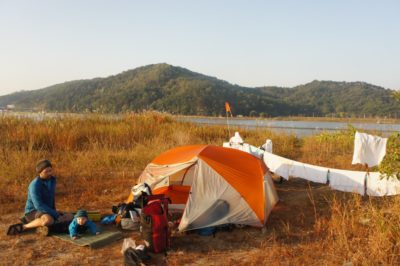
Diapers
When we did our three month trip to Korea and Japan, when Neil was 7 to 10 months old, we used cloth diapers. We brought with us about 30 big white cloth sheets and about 12 covers. Because of that we had to wash our laundry every 3-4 days. It wasn’t too bad, because after 3-4 days of cycling we felt like we needed a break anyway, so it was a good opportunity to do the laundry. In Korea if we stayed in hotels they were always happy to do the laundry for us (weird, I know), or they would let us use their washing machine. If it happened to be that we needed to wash diapers but we were camping Gili washed a few by hand (messy business). We brought with us a folding bucket that served as a sink for that purpose. We would usually hang them where we were camping but sometimes we had to dry them on the trailer while riding.
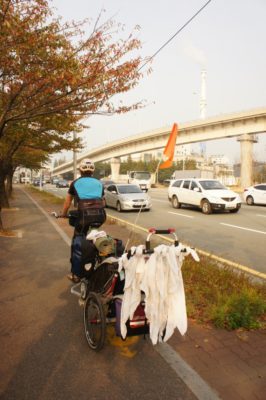
In Japan laundromats were very common and sometimes we could even do a wash during our lunch break. In general the weather in Japan was wet for us, so we couldn’t really dry the diapers in the sun like we did in Korea, so we had to use the dryer a lot more which took its toll on the diapers. By the end of the trip Neil had a lot more leaks and we needed to change his clothes often and that just increased the amount of laundry we needed to do.
We also carried a small amount of disposable diapers, and we always used a disposable at night. In retrospect, I think we could have just gone with disposable diapers, but we wanted to be environmentally friendly and not leave piles of diapers everywhere. We used cloth diapers at home, so we just thought we’d continue with what we were used to. We also didn’t know how easy it would be to find diapers whenever we needed or how much they would cost, and with the cloth diapers we always knew we would have them and could wash when needed.
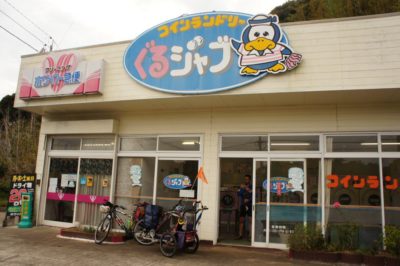
When we went to France, which was a three week trip, we decided just to go with disposable diapers, and it made life easier. Laundry in Europe turned out to be very expensive, and we mostly camped anyway, so we were happy with our decision and finding diapers in supermarkets was very easy. In New Zealand we continued with the disposable diapers (called nappies in Kiwi), and although they were expensive they were easy to find.
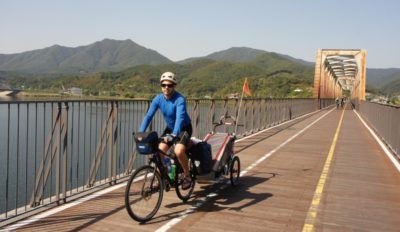
Choosing Your Destination
Choosing your destination can be tricky. For us a key factor, especially now with Neil, is to ride only roads with very light traffic or when possible dedicated bike paths. We chose South Korea since we had heard they have wonderful cycling infrastructure and we weren’t disappointed. In our two and a half weeks of crossing Korea by bike we followed a bike trail called the Four Rivers Trail. The trail follows rivers and streams, rice paddies and soy fields, and is a designated cycling path that is mostly separated from traffic. It was built and designed for cyclists and we crossed endless tunnels and bridges, most of them only for cyclists, and many were actually huge dams. Then we headed to Jeju Island, where we encountered some traffic, but once away from the cities, we were basically following a cycling path as well, which was right by the ocean and very scenic.
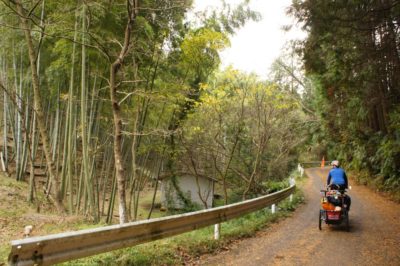
Japan was a bit more tricky, since they don’t have the same amazing cycling infrastructure as Korea. We cycled in Kyushu mostly on back roads with light traffic. Our main mistake on that section was cycling into Nagasaki, which is a big city, with main roads leading into it. For three days we were quite exposed to traffic (and rainy weather) and we didn’t like it, so from then on we kept away from main roads as much as possible. We found the drivers in Japan to be cautious and respectful of cyclists, so there was a silver lining to our Nagasaki experience, as well as the hospitality we encountered on the way.
We also cycled a few small islands on the way to Okinawa and beyond. Those islands were great for cycling as they didn’t have a lot of traffic and there were always nice beaches to stop at. Catching the ferries in between was an experience too, so in general we feel that island hopping is a great option with kids.
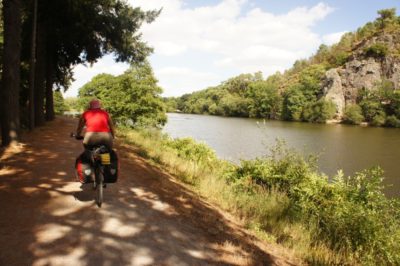
Our next overseas destination was France, when Neil was 18 months old. France has some of the best cycling infrastructure we’ve seen. We cycled in Brittany following canals, all on bike trails, passing through magnificent medieval towns along the way, enjoying a croissant or pain au chocolate every single day. Then we cycled along the coast, on quiet roads well marked for cyclists. It was our first time cycling in Europe and it opened our eyes to the endless possibilities Europe has to offer.
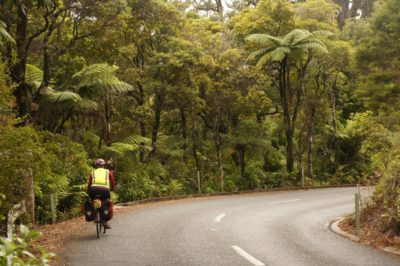
Just before Neil turned two we flew to New Zealand for a month. It was a tough winter in Vancouver and we were happy to switch over to summer. We were also excited about the flights as both flights were direct night flights which made things very easy with Neil – he slept 11 hours out of 14. Naturally we took our bikes with, but we soon realized that New Zealand was probably not the best option for cycle touring with a trailer. They don’t have the cycling culture and infrastructure like Europe, and the roads are very narrow, windy, hilly and with zero shoulder. We still had an excellent time, but we had to plan our route very carefully. We cycled in an area called Northland where we were able to find some back roads, some dirt roads and even a bike trail. However, this bike trail offered a different challenge, since it had dozens of gates we had to pass through. The gates had a narrow passage only for a bike, so we had to lift the trailer above almost all of them, sometimes while Neil was sleeping.
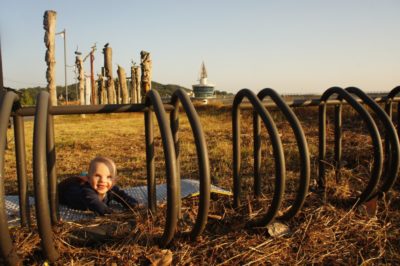
Keep Them Interested/Engaged
On our first trip, when Neil was less than one year old, keeping him interested was easy. He was usually a happy fellow in the trailer, mostly napping when we were riding. If he was awake and being a bit fussy but we still wanted or needed to cycle a bit more we would put on music for him, mostly Raffi, which always kept him happy. Our lunch breaks were usually quite long, he was still breastfeeding so we made sure to take enough time to eat, breastfeed and play with him. Gili was usually quite active with him in order to tire him out. We brought two books that we kept on reading to him to the point that we knew them by heart. We brought a few small toys along, but they proved useless after a short time. Neil played with everything accessible, menus in restaurants, the pot and bowls if we were cooking on the stove, our flashlights, the wheels of the trailer, and sand and sticks. People were also very generous and always wanted to spoil him with gifts so he collected a ball and a few stuffed animals along the way.
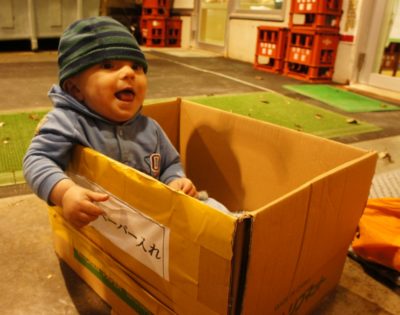
On the last two trips, when Neil was already a toddler, keeping him interested was more challenging, but in a way it was also more fun because he was much more engaged with the trip and what we were doing. If Gili was working on the bikes Neil was right there helping him out – there probably aren’t a lot of two year olds who know the names of all the parts of the bicycle and how to use Allen keys. The stove was definitely his favourite “toy” and if we wanted him busy the stove kept him going for a least an hour. Also stickers were a great discovery as they kept him busy on flights or if we had to take other modes of transportation such as a train, a bus or a ride in a car.
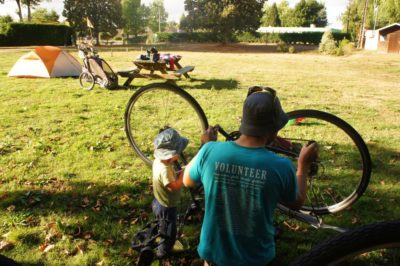
We spent a lot of our time in playgrounds which was also a cultural experience, since we could see parent-children interactions up close. Playgrounds were also very easy to come by. In France almost every campground had a decent playground, and in New Zealand there were also trampolines, zip lines, tall slides and fun swings. Also, Neil loved just hanging out on the beach playing in the sand or sometimes he just spent his time throwing rocks into a river. It was very rewarding to see how the small things kept him happy, not fancy noisy toys, and he was never bored.
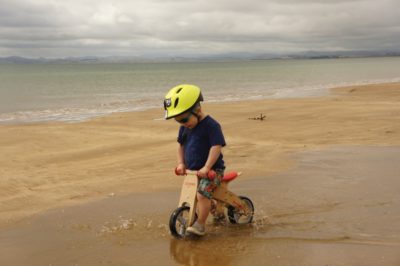
The best thing though that we brought along on our two recent trips was Neil’s balance bike. Almost every day after lunch Gili would take Neil for a ride on his bike and sometimes in the mornings and evenings too. Neil got to explore a lot of campgrounds, trails and towns that way and it gave him a lot of freedom and independence and many times he was leading the way. Of course, he always attracted attention from the locals.
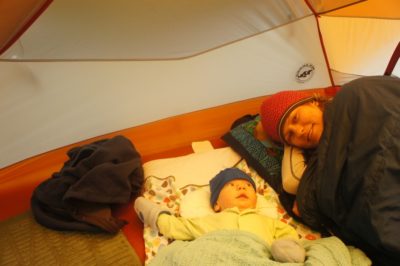
Camping
For us camping is the easiest way to travel – if you have your tent, you can have a home anywhere. There is something very easy and simple about camping, the freedom and being outside constantly. It’s usually easy to find a place to camp, it’s cheaper than any other accommodation, and it is in many ways stress free – there’s no need to worry about breaking anything indoors, or taking all our gear and bikes up stairs or an elevator.
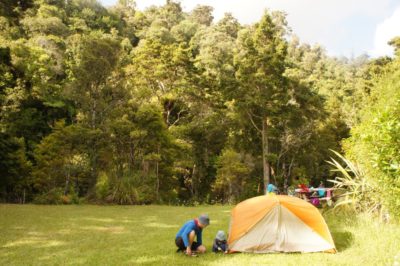
Neil loves camping and he is very excited about the tent and always helps to set it up, and of course loves the inside of the tent too – the blow up mattress and the sleeping bags. His first night in the tent was when he was three months old, and that was one of the first times he slept through the night. Of course, not all nights in the tent are easy, and we definitely had our share of rough nights, but in general it works great for us.
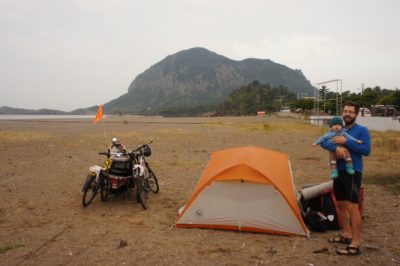
We were always big fans of wild camping in places where it is deemed OK. Both Korea and Japan were very camping friendly. In Korea, when we were following the Four Rivers Trail we often just camped on the side of the trail after we decided we had enough cycling for the day. On Jeju Island there were a few free campgrounds or sometimes we just camped on the beach.
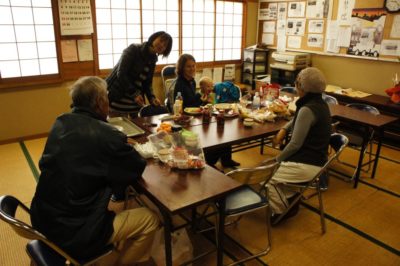
In Japan we intended to camp more as we heard it’s a camping paradise where cyclists can pretty much camp anywhere, but the weather was not so great. Japan has rest areas, called michi-no-eki where cyclists can pitch their tent, and we did it a few times which was excellent. Many times we planned on camping and already set up the tent, but then we were told it was impossible. Not that it wasn’t allowed, they just wouldn’t let two foreigners with a baby sleep outside in pretty cold weather. We were invited into people’s homes over and over and even spent the night at a community centre. The list of places we stayed at in Japan goes on and on and is quite bizarre, but no doubt those are our best memories. On our island hopping portion of the Japanese adventures we again camped in free campgrounds. Since it was off season, we were always by ourselves in the campgrounds, but as is typical in Japan, they were clean and tidy with fresh soap and toilet paper.
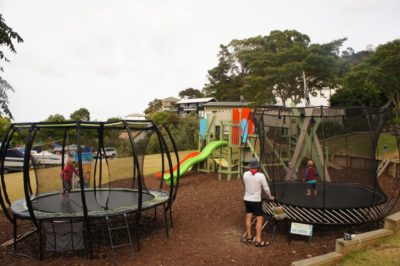
In France and New Zealand we mostly camped in campgrounds. In France they were very easy to come by and the price ranged from 4 to 14 euros a night. Most campgrounds came with a built in playground, and in some you could even order your croissant and baguette to arrive fresh in the morning. It was already the end of the season so most campgrounds were not so busy.
In New Zealand it was a different story. We were there at the peak of summer (their summer) and we didn’t realize that camping was so expensive, a couple of times we even paid $50 a night! True, those campgrounds were five stars and with amazing playgrounds and trampolines, but still. We heard that wild camping is frowned upon, although we would probably have done more of it if we were without Neil. They have areas designated for wild camping (freedom camping in Kiwi) and we stayed in those a couple of times.
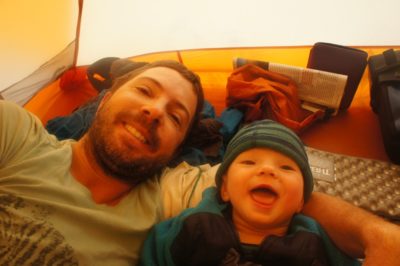
Tent Sleeping Arrangements
We carry an extra sleeping mat for Neil, a Therm-A-Rest Z-Lite Sol size small, and put it in between us. So far we have managed to get away with carrying just a small sheet for Neil, and we cover him with a thin but high quality down jacket. This has the advantage that the down jacket can double as a warm layer for one of us while Neil is awake. If it’s a cold night, we dress Neil extra warm, with a base layer and/or fleece.
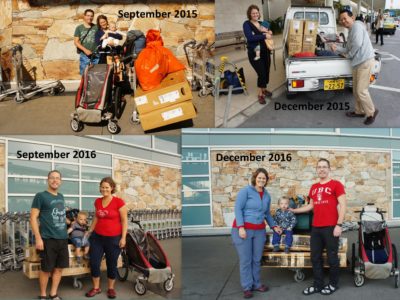
Transporting Your Bike
On all our trips so far, we have brought our bikes with us. For short trips, it might be more worthwhile to rent a bike, given the annoyances of transporting a bike. When travelling by plane, carrying a bike might be free or might cost you as much as $200 or more per bike per direction, so it’s worth checking before booking. Most airlines require you to box your bike. It’s usually easy to find used cardboard boxes for free by calling up a few bike stores nearby. Boxing your bike might take an hour or two the first few times you do it, so leave enough time. Try to get a box that belonged to a larger bike, it makes things easier. Some airlines will allow you to send your bike through in a large plastic bag, after removing the pedals and turning the handlebars. This also seems to be a good option, and there are endless debates online on whether boxes are better than plastic bags.
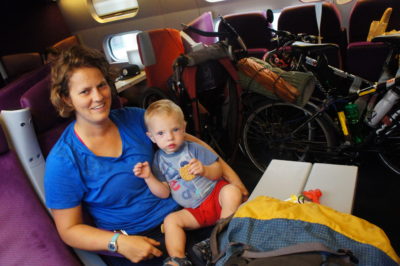
If you are planning to travel by bus or train, make sure to find out what the exact rules are in advance. Some bus companies will allow you to just wheel your bike into the hold, as happened to us in New Zealand. Other bus companies require you to box your bike even for a bus ride of a few hours, as Greyhound does on most routes. Many train companies will allow a few bikes on board each train – we did so in France, but check carefully which trains take bikes and whether they require dismantling your bike or not. Ferries are often the most carefree transportation solution, as they will often just allow you to roll on your bike for a small additional free.
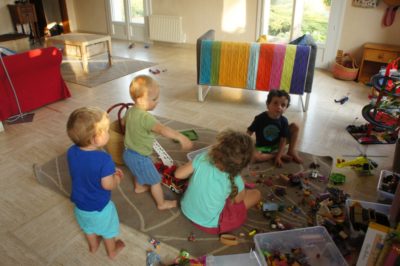
Warm Showers & Hospitality
If you used Warm Showers (or Couchsurfing) in the past, don’t hesitate to keep doing it despite having a kid. The worst that could happen is that people will tell you it doesn’t work for them. We actually had some of our best Warm Showers experiences with Neil. Both in France and New Zealand we stayed very comfortably with families with a few kids and Neil was happy to have other kids to play with, and they were happy to have another kid around.
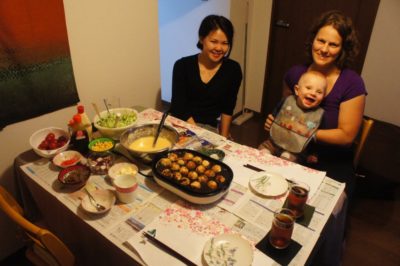
In Japan we met incredible people both through Couchsurfing and Warm Showers – in Fukuoka Asami hosted us for three nights, taking excellent care of us while showing us her home town and feeding us delicious Japanese food. In Okinawa Aki went out of her way to arrange bike boxes for us for our flight back as well as a ride to the airport with a friend of hers with a pick-up truck.
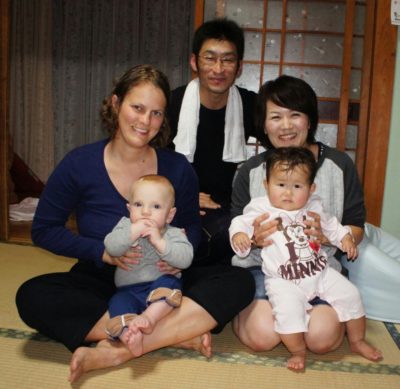
People also invited us over spontaneously, surprisingly often. In Japan we had the most random hospitality encounters. One of them was with a Japanese family with a baby exactly Neil’s age who took us in, right in the eye of the storm. We spent the evening with their extended family, and we still keep in touch with them. Another evening was spent with a Japanese grandpa who took us for a fun evening of okonomiyaki (a savoury pancake) and soaking in an onsen (Japanese hot-tub) and comfortably hosted us in his home.
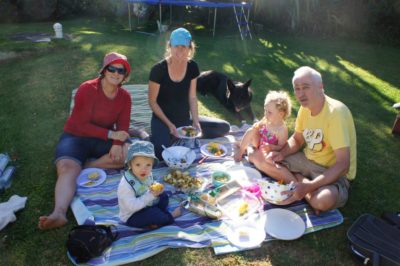
In New Zealand on our first day of riding which was quite challenging, both mentally and physically, a family chased us down a hill just to tell us that the campground where we intended to camp was closed. They immediately invited us over, and we spent two nights with them and their awesome three year old, which Neil still talks about. The only reason they chased us down and invited us over was because they saw the trailer and knew we had a baby. There is no doubt Neil opened many doors for us.
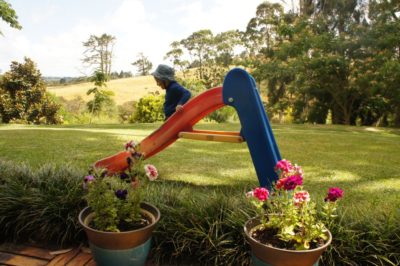
Every now and then we stayed in a hotel or a hostel, but we prefer Air B&B. It’s a great solution if there is no Warm Showers or Couchsurfing nearby, or if you just prefer it. In Kagoshima, where we finished our inland portion of our Japan trip, we rented a small apartment for four days. It was great to relax after a challenging four weeks of cycling, mostly in rainy weather, and to get to know the city. In Seoul we rented a room in a tiny apartment with a Korean couple, luckily Neil was not so mobile then, otherwise it wouldn’t have worked. In New Zealand, the two places we rented had a big yard, dogs and other animals which was great for Neil.
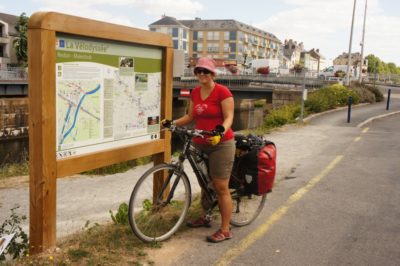
Distance
Most likely you’ll be cycling shorter distances than you were before you had kids. It’s best to define your expectations accordingly, which will make the trip more fun for everyone. On flat routes, like much of our trips in France and South Korea, we cycle an average of 50 kms a day. On hilly terrain or gravel roads, such as most of our trip to New Zealand, it might be as little as 30 kms. For us, cycle touring is not about the distance we cycle, it’s about the experiences we have along the way. We take lots of breaks, both to enjoy and explore our surroundings, as well as to allow Neil to play and do all the usual baby things.
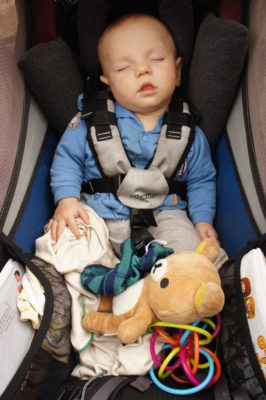
How and when you cycle will depend on you and your child, as well as on the terrain and attractions along the way. Our net daily riding time is usually between three and four hours. It typically takes us a good two and a half hours to pack up camp, eat and so on, and by that time Neil is likely to fall asleep not too long after we head out. That gives us maybe around an hour and a half of riding before he needs a break, at which point we take an extended lunch break. Once Neil has eaten, played and run around plenty, he’s ready to get back into the trailer. At that point he might fall asleep again, or maybe we’ll ride for an hour, take another break and then he’ll fall asleep. We find it’s good to go with the flow, and having a tent, stove and food with us means that we can be flexible about where and when to stop.
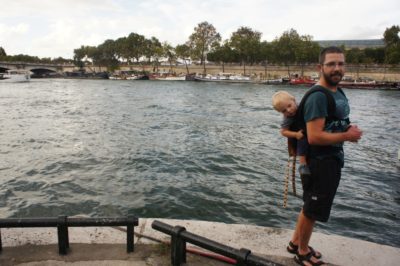
Our cycle touring trips aren’t focused only on cycling. We feel that in the days we cycle we actually have more routine and structure to our day, but we also take lots of rest days when we don’t cycle at all. We rest, explore the town or area we are in, eat well, go to the beach, the pool or to the aquarium. We use buses or trains to get around or we walk. For Neil anything that is not a bike or his trailer became a novelty, even a ride in a car. For all our trips we brought with us our Ergo carrier, which can be used front facing or on the back. It’s also a good idea to give your family the time to adjust, especially if there is a time difference involved. On the first nights of our trip to France Neil was up between 2am and 5am.
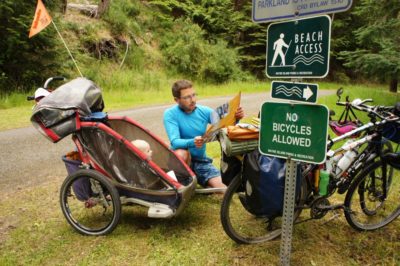
Start Small
It’s a good idea to test the waters with some short trips. This will allow you to start getting an idea of what works for your family, find out if you have the right gear, and allow you to gain some confidence and an idea of what is possible. We get around our home city almost exclusively by bike, so we had plenty of opportunities to get used to towing a trailer, as well as getting Neil used to it. Then we did some half day and full day trips from home, and weekend trips such as heading to the nearby Gulf Islands.
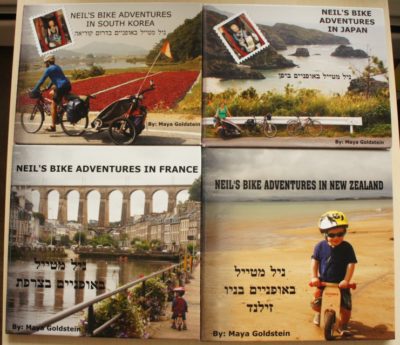
Keep the Memories Alive
So what happens when you get home? For us usually for the first week or so we are really excited to be back home. We love our life in Vancouver and the routine we have developed, but not long after we’re back we start thinking about the next trip. However, we also keep on talking and thinking about our previous trips. One of the things that really helps to keep the memories alive is photo books. For each of our overseas trips I wrote a story with photos for Neil. He loves those books and almost every day we read either Korea, Japan, France or New Zealand, or sometimes all of them. Neil improved his vocabulary based on these books, and he remembers names of people and places we’ve been to. So every day we get to re-live at least one of our trips through his little eyes.
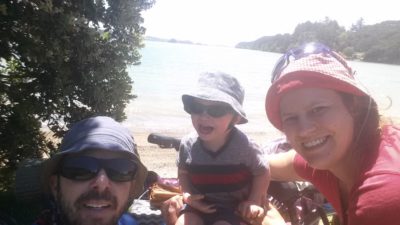

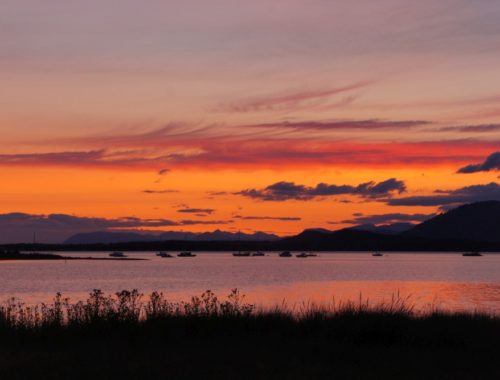
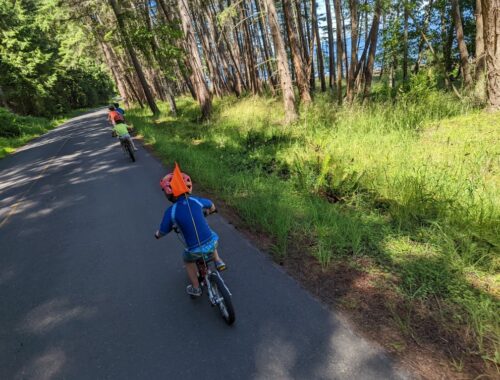
5 Comments
Peta Kaplan
This is a terrific comprehensive guide that no doubt would be useful to other parents contemplating something similar. It’s definitely interesting reading the pros and cons.
I did wonder about the cloth diapers and how you managed….That is a pretty funny picture of them drying while riding.
The photos are great and the trip photo books such a terrific idea. We made those as well from quite a few of our trips… and love looking at them. It is nice to hold them in your hands especially now that people don’t print photos that much anymore. I can see how Neil would enjoy looking at those over and over.
Peta
Andy
This is incredibly helpful, thank you so much for putting your experiences down in words. My daughter is 15 months now and I’m eagerly thinking about the bike touring possibilities. I’ll be referring to this post over and over
Maya
Hi Andy, really glad you enjoyed this blog post, we really just wanted to share our experience and to show that it’s not only possible to tour with a kid, but also lots of fun. I hope you’ll discover it very soon. Also, sorry for the delay in replying, we were actually cycle touring in Washington and Idaho for a couple of weeks, it was amazing!
Sandra
What a wonderful post and brings back so many great memories. 🙂 We took our 10 month old along the Rhine River cycle. ~1600km through 6 countries from Switzerland to the ocean. Almost identical set up to you. Would recommend it! Latest cycle tours were in quebec. Good, but with the trailer, recommend only paved routes. Found some good ones through the Eastern townships! I’ll be looking up the cycle you did in Korea! We’re looking for more flat-ish safe (low traffic or separated path) longer distance trips for our family (now a preschooler and toddler). Thanks for the post!
Maya
Hi Sandra,
Thanks glad you enjoyed the blog post! Your Trip in Europe sounds amazing. I think we’ll be looking for more things like this in the future. You should definitely check out South Korea! It’s mostly flat, completely separated from traffic, you can basically camp anywhere and accommodation is not so expensive either: http://inmagicland.com/2015/10/south-korea-part-1/ Let us know if you have any questions or need more info!